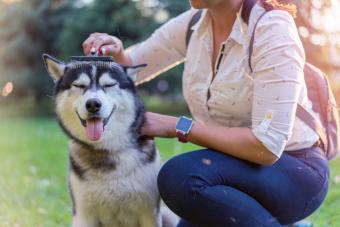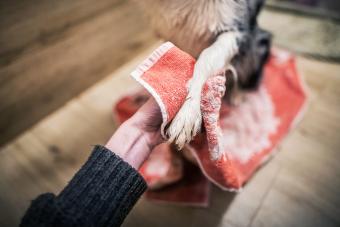
Getting a dog really clean involves more than just giving them a quick bath. Follow these steps for brushing, bathing, and trimming, as well as cleaning their ears and teeth, and you'll have the cleanest, freshest-smelling dog around.
Mission: How to Clean a Dog Completely
Dog owners love their canine buddies, but no one wants to be around a dog with a bad odor. This makes regular dog grooming sessions a must for every pet.
When groomers talk about getting a dog clean, they're talking about a few very specific missions.
- They want them to smell clean.
- They want their fur to look clean.
- They want their dog to appear well kept.
Admittedly, this is harder to achieve with some breeds than others. Some dogs are of the "wash and wear" variety, while others require extensive brushing and clipping to make them look their best.

Grooming Steps
The basic steps involved in grooming a dog are outlined below:
Brushing
Brushing is any dog owner's first line of defense in the battle to keep a dog clean. This task should be carried out on a weekly basis for short-coated dogs, and at least every other day for long-coated breeds.
Brushing removes loose fur, prevents matting, gets rid of existing mats, and helps eliminate dirt and debris. A thorough brushing is essential before giving your dog a bath.
Ear Cleaning
Dirty ears can cause odors and lead to infections. Some owners prefer to clean out a dog's ears prior to a full bath, but you can always take care of this task after bathing if you prefer. To clean the ears:
- Soak a cotton ball in commercial canine ear washing solution.
- Begin by wiping out the inside of the ear leathers.
- Gently pull out small sections of hair if your breed is one that grows a lot of hair in the canals. This improves air circulation, which in turn makes the canals less hospitable for bacteria and mites.
- Once excess hair is removed, soak a cotton swab in the cleaning solution, and try to remove any debris you might find a little deeper in the canal. Be careful not to go in too deeply.
Tooth Brushing
No grooming session is complete without giving your dog's teeth a good brushing. You can choose to use doggie toothpaste or simply use water. Start at the back teeth and gently work the brush against the teeth in a circular motion, taking care to clean the gum line especially well. Remember to clean front and back surfaces.
Bathing
Bathing is the single most important step to really clean a dog. It's honestly better to forego the tub full of suds in favor of a spray hose setup. It will be easier to see if you're really getting your dog clean when they're not submerged.

- Adjust your water temperature to a comfy setting.
- Have your shampoo, optional cream rinse, and towel in hand.
- Place your dog in the tub and use the sprayer to wet them down. Be extra careful around your pet's head so you don't flood their eyes, nostrils, and ears.
- Once your dog is thoroughly wet, apply the shampoo. Start at your dog's head and work your way back through the tail. Next, soap their undercarriage and legs. Don't forget to wash between their foot pads.
- Starting at the head, rinse all the suds out of your dog's coat. Repeat the shampooing process one more time to make sure they're squeaky clean.
- After the shampoo, you may choose to work some cream rinse through your dog's coat in the same manner as the shampoo. Although not every coat type requires cream rinse, most will benefit from it. This product is essential for long-coated dogs since it will make the post-bath brushing easier.
- Rinse out the cream rinse and give your dog a final once over to make sure you've removed all visible dirt.
- Squeeze out as much excess water as possible, and towel dry your dog. Take care not to scrub long fur or it may become matted.
Drying
Some people prefer to skip the drying step, and this is acceptable in some cases. However, blow drying does give the coat a finished look and is required for long coats in order to keep your dog from becoming chilled. It also makes it easier to brush out mats.
Nail Clipping
Once your dog is clean and dry, it's time to carry out any clipping they might need.
First, examine your dog's nails to see if they need to be trimmed. Some people prefer to do this before the bath, but this leaves sharp edges on the nails. If you want to avoid being scratched, leave this task until after the bath.
Only trim the nails up to the pink "quick" just barely visible through the nail. If you go any further, the nails will bleed and your dog is sure to yelp. When dealing with black nails, just remove the tips.

Fur Trimming
Some extra trimming may be necessary to help your dog stay clean. Check their pads to determine if the hair between them needs to be trimmed a bit. Excessive pad hair can become matted and also trap debris.
You might also choose to trim a small amount of hair away from the anus of a long-coated dog to keep stools from becoming trapped. Use caution, as this can be a sensitive area for dogs.
Finally, a long-coated dog will benefit from having the overall length of their coat trimmed level with the floor. You can also round off the paws to give them a clean, finished look.
Take Satisfaction in a Job Well Done
Now you know how to really clean a dog just like professional groomers do. With a little practice, no one will be able to tell that you groomed your dog yourself!







